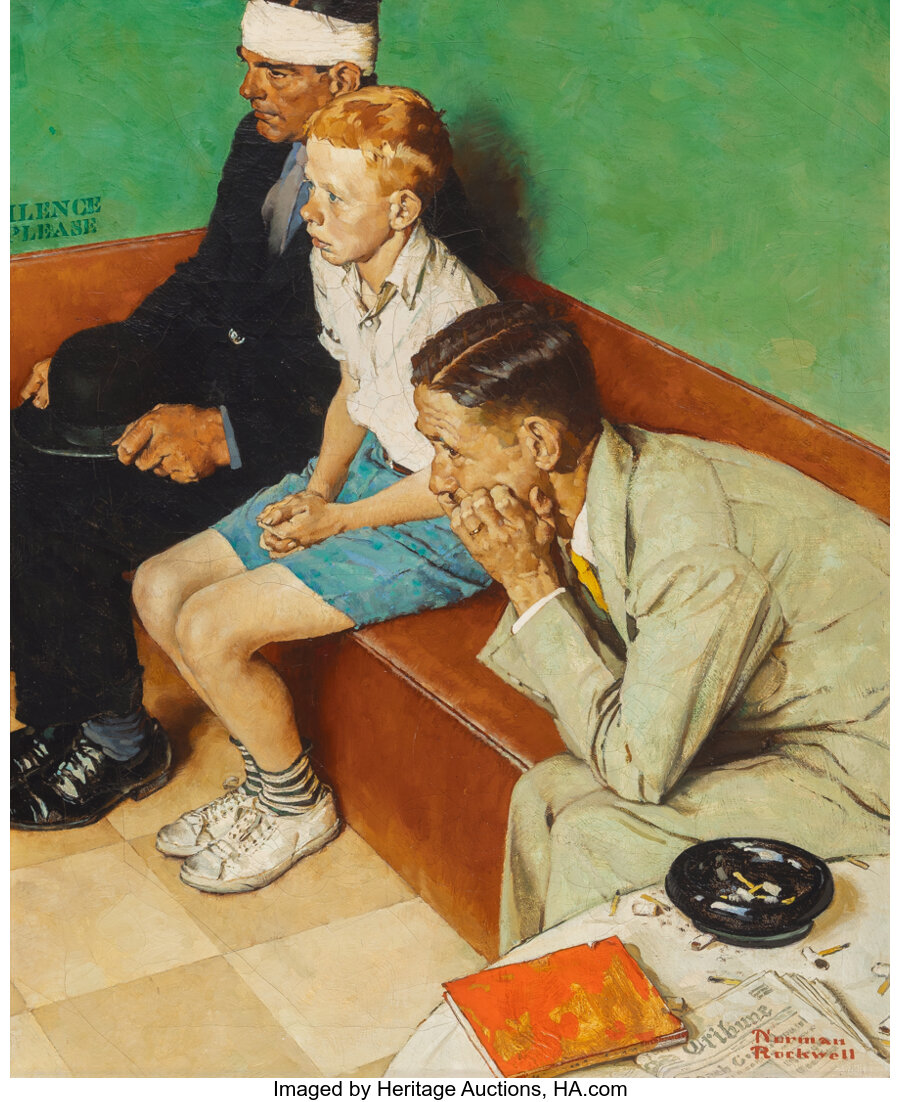Norman Rockwell (American, 1894-1978) Waiting Room, The Saturday Evening Post interior, October 16, 1937 Oil on canvas 28 x 23 inches (71.1 x 58.4 cm) Signed lower right: Norman / Rockwell Property from the Collection of the Late Mort Künstler PROVENANCE: Sotheby's, New York, May 24, 2000, lot 197; Acquired by the present owner from the above. EXHIBITED: Art Museum of Western Virginia, Roanoke, Virginia, "Norman Rockwell – Presenting the American Century," September 29, 2001 - January 20, 2002; The Nassau County Museum of Art, Roslyn, New York, "Norman Rockwell: American Imagist," September 20, 2009- January 3, 2010; Christie's, New York, "Illustrating America: Norman Rockwell and His Contemporaries," November 30-December 20, 2013. LITERATURE: P. Day, "22," The Saturday Evening Post, October 16, 1937; A.L. Guptil, Norman Rockwell Illustrator, New York, 1946, hardcover, pp. 84, 171, illustrated; A.L. Guptil, Norman Rockwell Illustrator, New York 1972, softcover, p. 84, illustrated; M. Moline, Norman Rockwell Encyclopedia: A Chronological Catalog of the Artist's Work 1910-1978, Indianapolis, Indiana, 1979, p. 112, fig. 2-51, illustrated; L.N. Moffatt, Norman Rockwell: A Definitive Catalogue, Vol. 2, Stockbridge, Massachusetts, 1986, p. 761, fig. S545, illustrated; Art Museum of Western Virginia, Norman Rockwell - Presenting the American Century, exhibition catalogue, 2002-2003, back cover, interior, illustrated. "Daniel sat stiffly on a leather couch, on his right a sodden man with a bandaged head, on his left an expectant father..." - P. Day, "22," The Saturday Evening Post, October 16, 1937, n.p. Norman Rockwell possessed an extraordinary gift for rendering everyday experiences into emotionally resonant narratives, a quality vividly exemplified in The Waiting Room, first published in The Saturday Evening Post on October 16, 1937. In this quietly powerful painting, Rockwell distills the universal experience of anxious anticipation into an emotionally charged vignette, transforming a mundane doctor's office into a compelling scene of human drama. Rockwell's national prominence emerged through his decades-long collaboration with The Saturday Evening Post, where he produced over 300 covers. This partnership firmly positioned Rockwell's illustrations as symbolic reflections of American life, resonating profoundly with audiences who found comfort and recognition in his images. His work provided visual reassurance during periods of upheaval, notably the Great Depression and World War II, thus significantly contributing to America's twentieth-century cultural identity. In The Waiting Room, Rockwell situates three figures within the familiar yet emotionally loaded space of a doctor's office—a setting emblematic of communal vulnerability and deeply personal anxiety in American culture. The painting eloquently portrays each character's private apprehensions: an older man with a bandaged head stares stoically forward, suggesting quiet endurance; beside him, a young boy, his hands tensely clasped and sneakers pressed anxiously together, conveys youthful unease; nearest the viewer sits a man leaning forward in contemplation, absorbed by his silent uncertainty. Though physically close, the figures remain emotionally isolated, underscoring Rockwell's profound insight into human nature. The muted color palette—soft greens, gentle browns, and warm reds—enhances the subdued emotional tenor, creating an atmosphere of quiet introspection. Rockwell's meticulous attention to detail, from the textures of clothing to the patterned tiles of the floor, amplifies the realism and deepens the painting's emotional resonance. Through carefully orchestrated visual rhythms and subtle gestures, Rockwell directs the viewer's attention through this narrative moment, drawing out universal feelings of hope and apprehension. Historically, the doctor's office occupies a significant role in American culture, representing a shared space of vulnerability, anticipation, and the human condition of waiting. By selecting this space as his subject, Rockwell acknowledges and celebrates the quiet profundity found within life's everyday moments, inviting viewers to recognize the dignity and emotional weight inherent in seemingly ordinary experiences. Fittingly, The Waiting Room belonged to famed artist Mort Künstler (1927–2025), a renowned visual storyteller celebrated for his meticulous historical paintings and dynamic illustrations. Künstler, like Rockwell, possessed a unique capacity for capturing emotion, narrative, and authenticity in his work. Both artists excelled in their ability to convey profound yet subtle human experiences beyond the spoken word, uniting them through their shared dedication to emotional storytelling. The provenance of this painting thus enriches its narrative, linking two masterful artists who illuminated deeper human truths through visual imagery. HID12401132022 © 2024 Heritage Auctions | All Rights Reserved www.HA.com/TexasAuctioneerLicenseNotice
Art Museum of Western Virginia, "Roanoke, Virginia, Norman Rockwell – Presenting the American Century," September 29, 2001 - January 20, 2002; The Nassau County Museum of Art, Roslyn, New York,"Norman Rockwell: American Imagist," September 20, 2009-Sunday, January 3, 2010; Christie's, New York, "Illustrating America: Norman Rockwell and His Contemporaries," November 30 - December 20, 2013.
Sotheby’s, New York, May 24, 2000, lot 197. Acquired by the present owner from the above.
Unlined canvas. Craquelure throughout. Stretcher bar lines visible along the edges of the work. Expanded condition report available upon request.
Framed Dimensions 36.5 X 31.5 Inches



